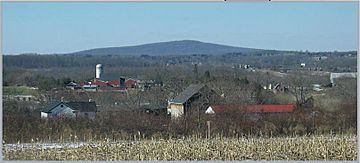Haycock Mountain facts for kids
Quick facts for kids Haycock Mountain |
|
|---|---|

Haycock Mountain
|
|
| Highest point | |
| Elevation | 974 feet (297 m) |
| Prominence | 400 ft (120 m) |
| Geography | |
| Topo map | USGS Riegelsville |
| Geology | |
| Age of rock | Triassic |
| Mountain type | Intrusive igneous / trap rock |
| Climbing | |
| Easiest route | Hike |
Haycock Mountain is a well-known hill in Bucks County, Pennsylvania. It is actually the highest point in the county! This mountain stands tall above Nockamixon State Park. Early settlers gave it its name because it looked like a large pile of hay.
Haycock Mountain is famous for its many large rocks, called boulders. These rocks are made of a tough material called diabase. Because of these boulders, it's a popular spot for bouldering. Bouldering is a type of rock climbing done on small rocks without ropes. There are many climbing paths here, from easy (V0) to very hard (V10+).
To the north of the main peak, there's a smaller peak about 820 feet (250 meters) high. People sometimes call it 'Little Haycock'. The main peak also looks out over Lake Nockamixon to the southeast.
Haycock Mountain is part of the Tohickon Creek watershed. This means that water flowing from the mountain eventually goes into Tohickon Creek. Dimple Creek drains the western side, and Haycock Creek drains the eastern side.
Since Haycock Mountain is located within State Game Land Number 157, it is used for hunting during certain times of the year.
How Haycock Mountain Was Formed
Haycock Mountain was created about 200 million years ago. This happened when hot, melted rock, called magma, pushed its way into the ground. It went into layers of softer rock like shale and argillite in an area called the Newark Basin.
From Magma to Mountain
As the magma slowly cooled down, it turned into a very hard rock called diabase. This diabase was much stronger than the rocks around it. Over millions of years, wind and water slowly wore away the softer shale and argillite layers. This process, called erosion, left the tough diabase exposed. That's how Haycock Mountain looks today, standing tall because its rock is so durable.
The Baked Rocks of Haycock
Besides diabase, Haycock Mountain also has a lot of hornfels. Hornfels is a type of rock that was baked by the heat from the magma. Imagine putting clay in a very hot oven – it changes! The same thing happened to the sedimentary rocks around the magma.
The hornfels is darkest and most noticeable close to where the magma pushed through. However, the magma was so hot that it changed rocks almost a mile away! These rocks turned a reddish-brown color, even far from the main heat source.


